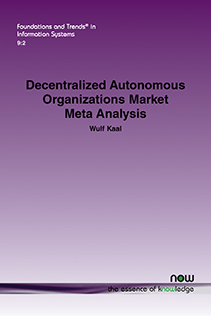Decentralized Autonomous Organizations Market Meta Analysis
By Wulf Kaal, University of Saint Thomas, USA, wulf@wulfkaal.com
Abstract
Decentralized Autonomous Organizations (DAOs) represent a transformative approach to governance and decision-making, driven by technology that enables decentralized, transparent, and direct stakeholder participation. DAOs are disrupting traditional centralized models across various industries. For instance, they offer alternatives to conventional banking and investment systems by facilitating decentralized asset management and peer-to-peer transactions. In the insurance sector, DAOs streamline claims processing, reduce fraud, and enhance risk assessment accuracy. They also provide solutions to combat misinformation and censorship through community-driven news platforms.
However, several challenges and open questions persist for DAOs. Key issues include the need to establish standardized governance mechanisms to ensure fairness, security, and accountability. Additionally, scalability concerns, legal frameworks, and interoperability between different DAOs are critical areas requiring further exploration and development.
This monograph presents an analysis of the DAO marketplace that utilizes a dataset of 50 DAOs selected by the assets size in their treasuries across different industries. Through descriptive statistics and comprehensive analysis, the monograph identifies trends in DAO industries and highlights governance and other shortcomings in the evolving landscape of DAOs.
Decentralized Autonomous Organizations Market Meta Analysis
Decentralized Autonomous Organizations (DAOs) represent a significant shift in the evolution of business entities, offering decentralized, transparent, and efficient alternatives to traditional corporations. While earlier business forms, from guilds to joint-stock companies, advanced with industrialization and the rise of multinational corporations, the Information Age has enabled DAOs through blockchain technology. Unlike conventional firms governed by boards and executives, DAOs rely on smart contracts to automate processes and encode governance rules, reducing reliance on intermediaries and enhancing efficiency and trust. Governance models in DAOs—ranging from token-based voting to reputational systems—reflect their participatory and decentralized ethos. Decentralized Autonomous Organizations Market Meta Analysis analyzes 50 DAOs across industries, identifying trends and challenges through six factors: decentralization, attack resistance, governance, regulatory compliance, work-to-earn mechanisms, and communication. By highlighting both the opportunities and shortcomings of DAOs, the monograph advances understanding of their transformative potential and provides guidance for researchers, practitioners, and policymakers navigating this emerging organizational paradigm.
